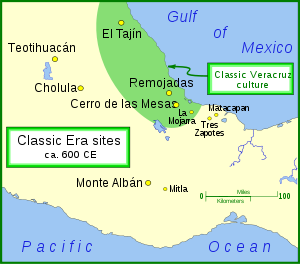
La Mojarra
Encyclopedia

Archaeological site
An archaeological site is a place in which evidence of past activity is preserved , and which has been, or may be, investigated using the discipline of archaeology and represents a part of the archaeological record.Beyond this, the definition and geographical extent of a 'site' can vary widely,...
in the Mexican state of Veracruz
Veracruz
Veracruz, formally Veracruz de Ignacio de la Llave officially Estado Libre y Soberano de Veracruz de Ignacio de la Llave , is one of the 31 states that, along with the Federal District, comprise the 32 federative entities of Mexico. It is divided in 212 municipalities and its capital city is...
, located not far from the Gulf Coast
Gulf of Mexico
The Gulf of Mexico is a partially landlocked ocean basin largely surrounded by the North American continent and the island of Cuba. It is bounded on the northeast, north and northwest by the Gulf Coast of the United States, on the southwest and south by Mexico, and on the southeast by Cuba. In...
at a bend in the Acula River. It was continually occupied from the late Formative period (ca. 300 BCE) until perhaps as late as 1000 CE.
Not a large site, La Mojarra has been little excavated. It covers roughly 1 km² and consists of small mounds and a modest plaza. Three kilns were constructed during the, used to fire locally used orange pottery.
Nonetheless, La Mojarra and environs have yielded two important Epi-Olmec culture
Epi-Olmec culture
The Epi-Olmec culture was a cultural area in the central region of the present-day Mexican state of Veracruz, concentrated in the Papaloapan River basin, a culture that existed during the Late Formative period, from roughly 300 BCE to roughly 250 CE. Epi-Olmec was a successor culture to the Olmec,...
artifacts: La Mojarra Stela 1
La Mojarra Stela 1
La Mojarra Stela 1 is a Mesoamerican carved monument dating from the 2nd century CE. It was discovered in 1986, pulled from the Acula River near La Mojarra, Veracruz, Mexico, not far from the Tres Zapotes archaeological site. The by , four-ton limestone slab contains about 535 glyphs of the...
and the Tuxtla Statuette
Tuxtla Statuette
The Tuxtla Statuette is a small 6.3 inch rounded greenstone figurine, carved to resemble a squat, bullet-shaped human with a duck-like bill and wings. Most researchers believe the statuette represents a shaman wearing a bird mask and bird cloak...
. Both of these artifacts contain what has been classified as Epi-Olmec script as well as very early Long Count calendar
Mesoamerican Long Count calendar
The Mesoamerican Long Count calendar is a non-repeating, vigesimal and base-18 calendar used by several Pre-Columbian Mesoamerican cultures, most notably the Maya. For this reason, it is sometimes known as the Maya Long Count calendar...
dates.

